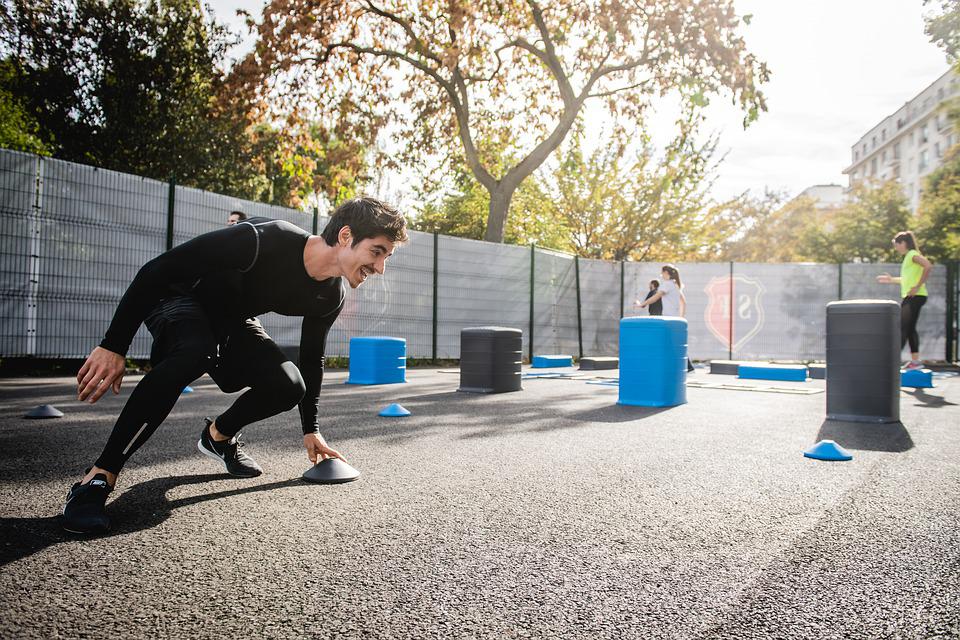
If you want to improve your fitness levels more quickly, consider adding sprint training to your schedule. Adding intervals of faster sprints alongside slower intervals can give you impressive results. Sprint workouts are ideal for people who don’t have time for long, steady, endurance exercise but who still want the same (or better) cardiovascular benefits.
How to Do Sprints
While many equate sprinting with running, the reality is that you can sprint while doing any aerobic activity, be it swimming, cycling, roller skating, or working out on an elliptical machine. When used in this context, sprinting refers to varying the intensity of the activity. The secret to successful sprinting is doing an activity at a certain percentage of your maximum effort in order to raise your heart rate.
Sprint workout routines should be performed three times a week, with at least one or two days of rest or another easy exercise in between.
- Warm-up. Before sprints, warm up thoroughly with easy exercise for five to 10 minutes. Perform the same exercise you will be using for your sprints.
- Do your first sprint. Perform your first sprint at about 60% max intensity. If you feel any muscle tightness or joint pain, back off and continue to warm up.
- Recover. Recover for four minutes by slowing to a comfortable pace, but keep moving.
- Do your second sprint. Perform your next sprint at about 80% max intensity.
- Recover. Recover for four minutes.
- Do your third sprint. Perform the remainder of your sprints at 100% max intensity or all-out efforts of 30 seconds. You should be pushing yourself to the max for each one.
- Recover. Recover for four minutes after each sprint to allow your breathing and heart rate to slow to the point that you can hold a conversation without gasping.
- Repeat. Repeat the sprint/recovery routine four to eight times depending on your level and ability. For your first workout, you will want to stop at four sprints. Try to gradually build up to eight.
Other Variations of Sprints
There is no one size fits all when it comes to sprinting routines. The intensity, duration, and number of sprints should be tailored to your specific fitness goals.
Beginners
If you’re just starting out with sprinting, go slowly at first to avoid getting injured. Build up your fitness level before adding sprinting to your workout routine. When you’re ready to try sprints, start with one set of four sprints, followed by a period of rest. As you get in better shape, you can add more sprints to each set, or add another set of sprints.
Intermediate
If you start doing sprint exercises regularly, you may only have to wait a few weeks before you can progress to a more advanced level. Slowly increase the number of sprints you do, and vary the intensity levels. However, don’t do sprint exercises more than a few times a week, or you’ll risk overworking your body without giving it enough time to recover.
Advanced
The following text is about how advanced or elite athletes can improve their sprint routine. One way to do this is by adding resistance. For example, if you’re running or cycling, you could try sprinting hills. If you’re skating, you could wear wrist and ankle weights to increase your load. Swimmers can use strength-building techniques to focus on just the upper or lower body or add resistance with tools like a Push Plate.
Common Mistakes
There are a few mistakes that are commonly made by sprinters. These include starting too hard, advancing too quickly, and doing too many sprints for too long. Sprints, by definition, are not meant to be performed at the expense of more moderate-intensity exercise.
You should remember that the goal is to modulate the intensity of your aerobic activity. A study published in Biology of Sport showed that if you don’t get enough rest between sprints, you won’t be able to perform as well during the sprint phase. This is because insufficient rest means you won’t get as much benefit from the same amount of effort.
Safety and Precautions
Sprint workouts can be done while running, swimming, cycling, or almost any other cardiovascular exercise. The following precautions should be considered before adding sprint training to your schedule:
- Safety: Because sprinting is a high-intensity exercise, it is recommended that you check with a healthcare professional and review the physical activity readiness questionnaire (PAR-Q) before beginning a sprint workout.
- Base fitness: It’s also important to have a strong base of fitness in the activity you are using for sprints. To build a base of fitness, follow the 10% rule, and gradually increase your training volume.
- Frequency: Because of the intensity of sprint workouts, most athletes shouldn’t do sprint work more than three times a week.
- Muscle soreness: Launching into a sprint program may be difficult or cause delayed onset muscle soreness (DOMS) if you haven’t done much training prior to trying sprints. Experts recommend having about three to four weeks of base fitness before beginning.
Warm up thoroughly before your sprint workout to avoid injuries.
10+ Benefits of Sprinting
- Allows your heart muscles to grow stronger
One benefit of sprinting is that it strengthens your heart. When you sprint, your heart has to pump harder, which improves blood circulation. This strengthens your heart and, as a result, can help improve your blood pressure.
Heart disease is more common in younger people than you may realize, so it’s very important to be taking good care of your heart health, even as a healthy runner!
- Builds strength
Sprinting is just as effective as weight training when it comes to building muscle mass. This is because it is an anaerobic exercise. Sprinting is more efficient because it works many muscles at once, while weight training usually focuses on only one area of the body at a time.
- Builds endurance
Sprinting can help you build endurance by teaching your body to use energy more efficiently. Sprinting maximizes your power and muscle endurance, which in turn can help increase your VO2 max and overall endurance.
Sprinting builds up a runner’s endurance because it trains the body to use more energy, faster.
- Increases speed
Sprinting increases your running speed, but it also makes you a faster runner over time by adding sprints to your workouts. Sprints require quick energy and over time, this makes your body more efficient at storing glycogen in your muscles. Sprinting is an anaerobic exercise, and over time, your body gets used to it and you increase your tolerance for the pain or soreness that you can experience after a hard sprint. Just make sure you plan for recovery days if you add sprinting to your training.
Speed work will help you to run faster overall.
- Reduces stress
Sprinting isn’t the only way to get the feel-good runner’s high that a long run also brings, but it’s a quick way to get it. Running in general helps reduce stress by circulating more blood to the part of your brain that responds to stress. Running also releases endorphins which gives you the post-run high.
Since sprinting is more effective than slow running, you will feel the effects of endorphins after only 15 minutes of sprinting. Both slow running and sprinting are great for stress relief, but sprinting is a quicker way to get the benefits if you don’t have much time.
- Improves metabolism
Springing, or jumping on a trampoline, is a great way to burn more calories in less time, and also increase your metabolic rate for days after your workout. This is called excess post-exercise oxygen consumption (EPOC), or “afterburn.” This means that you continue to burn calories even after your workout is finished.
High-intensity interval training has been shown to result in more fat loss than moderately intense activities such as jogging, especially when it comes to stubborn visceral fat. Additionally, HIIT has a host of other health benefits.
- Improves body composition
Running in general helps to reduce body fat, but if you only do steady exercise without varying it, it can actually be ineffective for reducing body fat stores. Sprinting is much more effective at causing weight loss because it is intense and diverse. You will not only see a change in your body composition on the outside, but your body will also grow stronger as a whole. Your hips will get a new range of motion, your hamstrings will work in a different way, you will engage your abs and torso differently, and you will start to notice that your body is better suited for running conditions.
- Takes less time with the same benefits
One great thing about sprinting is that it’s much faster than other types of workouts. Most regular runs take about 30-45 minutes, whereas sprinting only takes 20 minutes when you include the recovery time. To do sprint interval training, warm up for 10 minutes, then sprint for 1 minute and recover for 2 minutes. Repeat this 5 times. Although it’s strenuous, it’ll be over before you know it.
- Improves insulin sensitivity
Sprinting can help reduce the amount of glycogen stored in muscles, which can in turn reduce the amount of insulin in the body. Although insulin is necessary for the body, too much can lead to the body storing fat, and this can make it difficult to lose weight.
- Builds new mitochondria
A way to make more mitochondria in your body is sprinting, and the mitochondria is responsible for extracting energy from nutrients to produce ATP. ATP is the molecule for storing and transferring energy in cells. The more mitochondria you have, the more power you have available for your brain and body. It is better to have lots of mitochondria since lots of degenerative diseases are characterized by malfunctioning mitochondria.
- You can do it anywhere
You can sprint anywhere, even indoors, just like you can run anywhere. I actually prefer to do speed work on the treadmill so I can be more precise with my speed and time. But don’t let the lack of a track stop you from sprinting.Hill sprints are just as effective as sprints down your street.
Sprinting Tips And Techniques
Focus on head position
For perfect sprinting technique, focus on maintaining good posture and keeping your head in line with the rest of your body. Try to keep your face relaxed, with your tongue released from the roof of your mouth, your jaw unclenched, and the tension released from your forehead. You may be surprised how much stress you’re putting on your body by holding tension in these areas. Des Linden, one of my favorite professional runners, has a mantra: “Relaxed running is fast running.” It’s true!
Swing your arms
Swinging your arms vigorously while running will increase your stride length.
Practice plyometric exercises
If you want to improve your running economy and form, you should add plyometric exercises such as jump lunges, jumping squats, toe taps, and high skips to your workout routine. These exercises increase muscle power and will make you a better sprinter.
Start slow and increase the speed
While it can be fun to challenge yourself with speed starts, when you are just beginning to add sprinting to your workout routine, it is best to start by running at a normal pace and then gradually increase your speed until you are sprinting. After that, slow down again before coming to a stop. This will help reduce your risk of injury and make the experience more enjoyable.
Try hill sprints
”According to Geoff Walcott, a personal trainer and sprint coach, running uphill simulates the forward lean of the acceleration phase at the start of a race, while running downhill simulates overspeed running. However, the gradient shouldn’t be too steep for safety reasons.
Find a hill close to where you live and run up it six times. Walk slowly back down to recover before doing it again. The good thing about this exercise is that it does not take long. It is an ideal workout to do on days when you do not have much time. Pay attention to bringing your knees higher than usual as you run and use your front leg to propel yourself up the hill with each step.
Try It Out
The goal of this workout is to do it six times in two weeks, then back off to twice a week for maintenance for six to eight weeks before you change your workout. On the days following your sprint workout, do 20–30 minutes of the same aerobic activity at an easier pace to help recover but maintain your results.














